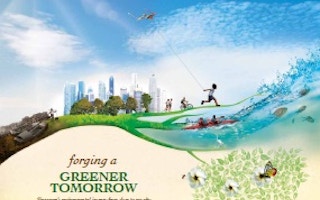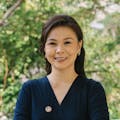Singapore’s Ministry of the Environment and Water Resources celebrates turning 40 this year and is launching a book for its anniversary.
It outlines the country’s journey from slum to a clean and green city, and offers insight into the environmental policies and projects that made this possible. The book will be unveiled on September 28 at the Singapore Environment and Water Awards ceremony. It can be downloaded on the ministry’s website after. The 206-page coffee table book is published by the Straits Times Press. The Prologue is excerpted here:
It was on the banks of the Singapore River where it all began. The water highway of the heart and soul of the modern metropolis that is now Singapore once saw Malayan princes and Portuguese raiders sail onto its shores to explore the rustic island. It was where Stamford Raffles eventually set up the first trading port of Singapore, paving the way for the modernisation of an island nation with no hinterland. The river was also home to squatters, coolies, hawkers and traders who shared the river banks alongside bumboats and tongkangs (a type of light wooden boat).
One of them was retiree Koh Chiew Tiong, 81. He arrived in Singapore from China’s Fujian province as a seven-year-old. He spent a large part of his life, from the 1950s to 1970s, along the river, living in a two-storey shophouse in Telok Ayer. He found work as a coolie along the banks. Speaking in the Hokkien dialect, he recalls: “In those days, the streets were dirty and filthy and hawkers lined the roadsides everywhere.”
Work was tough, but plentiful. A coolie since his 20s, he carried various goods – sacks of corn, provisions and even rubber squares – from the bumboats on the river onto the shore, to be loaded onto lorries. The company cook would rustle up a simple fare of noodles or rice for the workers. When food was not provided, he would go to the “New Market” – now known as Ellenborough Market – along Boat Quay: “There were many warehouses then, and shops that made fishballs. Hawkers sold coffee and cooked food in the area. We ate there and I remember the stench of the river before we could see it. And when we finally caught sight of it, the water was black,” he says.
The Singapore River – historic not just for its key role in Singapore’s economic survival – was also unforgettable for its putrid stench of rotting garbage, human and chemical waste. In a way, the river encapsulated the country’s mounting problems in those early post-independence days. Singapore had gained self-governance from the British a few years earlier in 1959, joined the Federation of Malaysia in 1963, and was booted out on 9 August 1965 due to bitter disagreements, with “no signposts to our next destination” as Singapore’s first prime minister Lee Kuan Yew wrote in his 2000 memoir. It was a “heart without a body” that had a population of 1.9 million largely unskilled people,
a nominal per capita Gross Domestic Product (GDP) of US$512 per year and unemployment rates of 10–12 per cent threatening to trigger civil unrest.
At that time, more than two-thirds of Singapore’s population was living in inner city slums and in squatter settlements on the city’s fringe. Mr Lee recalls: “Thousands would sell cooked food on the pavements and streets in total disregard of traffic, health or other considerations. The resulting litter and dirt, the stench of rotting food and the clutter and obstructions turned many parts of the city into slums.”
It was in those uncertain days that Singapore’s founding leaders set in motion an imaginative strategy that sought to create jobs and transform Singapore’s economy into an export-oriented industrialised one, even while aggressively tackling its housing, environmental and public health problems. Some efforts had begun as soon as Singapore achieved self-governance: in 1960, the Housing and Development Board (HDB) was set up to drive a massive home-building programme, while the Economic Development Board (EDB) was established to market Singapore to the world as the top emerging investment destination in Southeast Asia.
Creating jobs was key to Singapore’s survival but along with the growth of industries came air and water pollution. Water supply was also a critical priority as the country was heavily dependent on Malaysia for water. Singapore had signed two water agreements with Malaysia in 1961 and 1962 that gave it rights to obtain water from Johor, the Malaysian state closest to Singapore. While PM Lee had ensured these agreements were made part of Malaysia’s constitution during the separation, he was informed that Malaysia’s first prime minister Tunku Abdul Rahman had told a British diplomat: “If Singapore doesn’t do what I want, I’ll switch off the water supply.” As Mr Lee later recalled: “Every other policy has to bend at the knees for our water survival.”
In 1977 he posed a challenge to the Public Utilities Board (PUB) chairman Lee Ek Tieng: “Suppose we could capture every drop of rain in Singapore, could we become self-sufficient?”
Thus began PUB’s twin challenges of cleaning up Singapore’s waterways even as it worked to capture as much rainfall as possible by damming up the country’s various streams to increase the country’s water supply. Its work over the decades would eventually answer PM Lee’s initial question – Yes, Singapore could become self-sufficient through a variety of ways.
But added to the water challenge was the overwhelming task of building up Singapore’s infrastructure so as to keep up with modernising and housing the nation. The Public Works Department (PWD) under the Ministry of National Development (MND) began implementing sewerage and drainage systems that would improve waste disposal methods and alleviate floods; these floods had afflicted parts of Singapore, causing deaths and millions of dollars in damages.
The Anti-Pollution Unit (APU) was set up under the Prime Minister’s Office in 1970 to tackle increasing water and air pollution caused by Singapore’s rapid industrialisation, and the Environmental Public Health Division under the Ministry of Health (MOH) worked to control and eliminate the outbreak of infectious diseases rampant in those days such as cholera, typhoid and malaria.
PM Lee also personally launched nationwide environmental efforts such as the Tree Planting Campaign in 1963, which led to greenery sprouting along all roads, on vacant plots of land and new properties. All these efforts culminated in the “Keep Singapore Clean” campaign, which Mr Lee marked in 1968 as a “new bid for healthier and more wholesome social conditions in Singapore”.
It is against this backdrop that the Ministry of the Environment (ENV) was formed in 1972 to bring all aspects of pollution control and environmental health in Singapore under one organisation. It absorbed the departments under MOH and MND that dealt with pollution control and environmental health. With this new consolidated emphasis on the environment, the ministry embarked on various development plans that laid the foundation for Singapore’s First World infrastructure.
Today, the Boat Quay that was once so familiar to Mr Koh is no more. Singapore is now a cosmopolitan city of five million with a per capita GDP of US$50,123 in 2011 that enjoys low unemployment rates of two per cent. The water in the Singapore River, cleaned up in the ’80s, is not a murky black but a clearer shade of blue where fish survive and the stench is gone. Passenger boats ferry tourists up and down the river, while eateries, cafes and pubs that line the river banks inject a distinct buzz to the city centre. In the distance, the skyline of Singapore’s central business district is dramatically different from what Mr Koh remembers as a coolie. There are more, and taller, skyscrapers now and the new Singapore Flyer ferris wheel rotates slowly against the towering structures of the Marina Bay Sands integrated resort under a brightly-lit night sky.
Mr Koh’s son, Steven, now 55, who used to help his father carry goods from age 14, recalls clearly the day when bumboats were not allowed on the Singapore River banks, thus signalling the transformation of Singapore and the end of thousands of livelihoods which depended on the manual work.
He recalls with nostalgia the years he spent growing up along the river, helping coolies and making friends, but he appreciates the investment and work that Singapore has put into modernising the city. “The area looks so different now,” he says, “it’s so much cleaner and the Bay area is beautiful.” These days, new memories are made as the elder Koh, his son and grandchildren stroll along on the banks of the Marina Barrage, almost taking for granted the fresh, clean air and the lush greenery.
Singapore had, in the words of Lee Kuan Yew, “built and progressed”.
“But no other hallmark of success will be more distinctive than that of achieving our position as the cleanest and greenest city in Southeast Asia,” he wrote.
This is the untold story of the people who made this Singapore possible.











